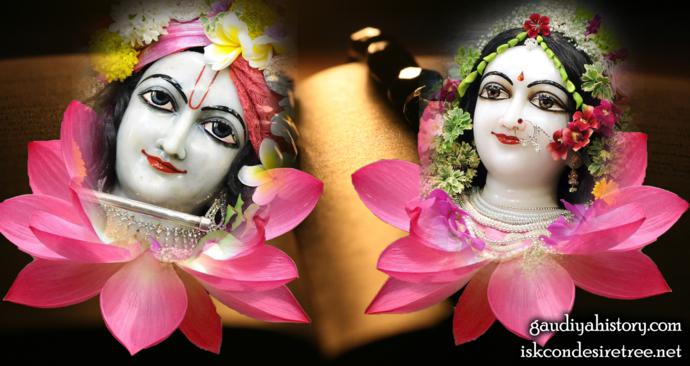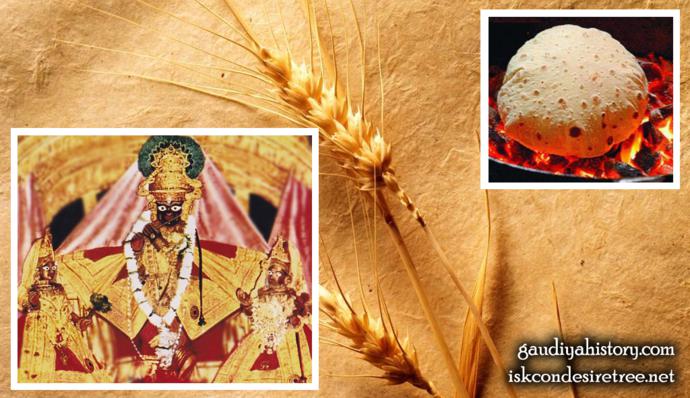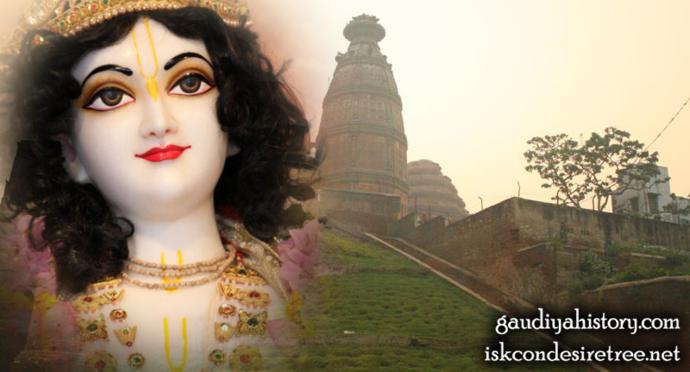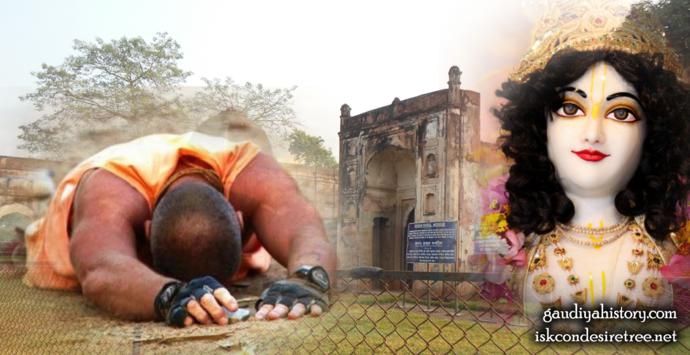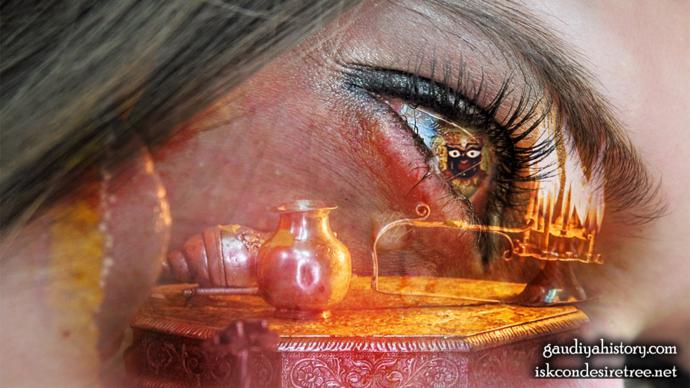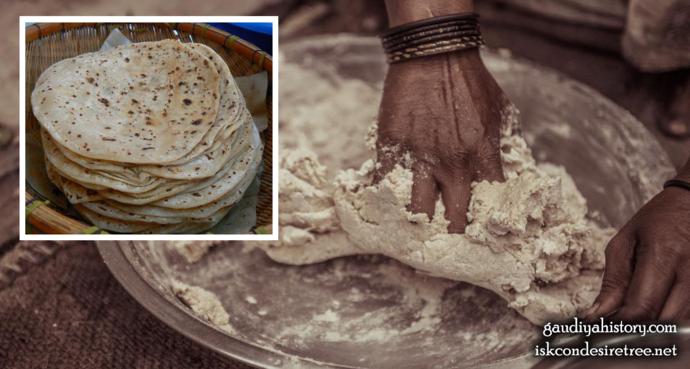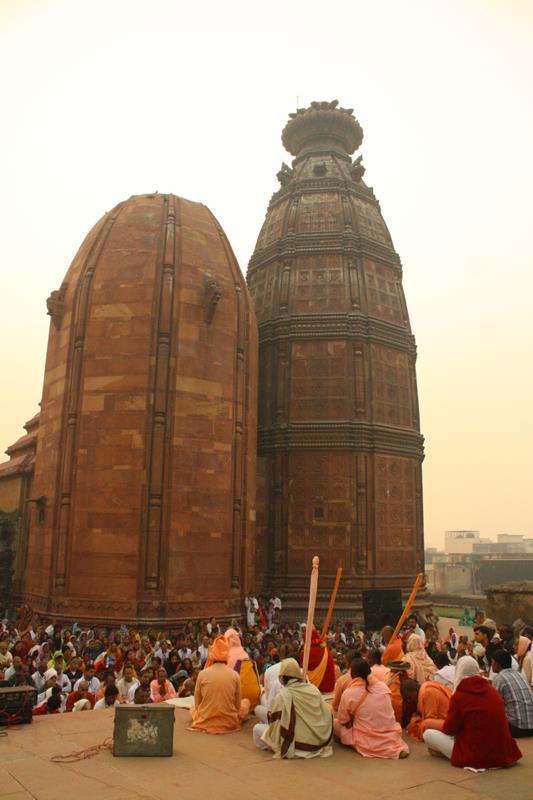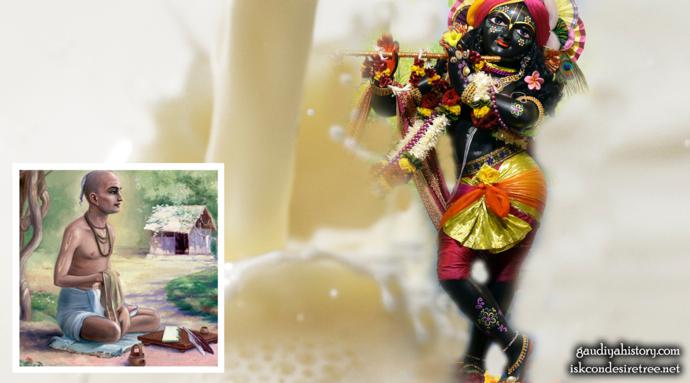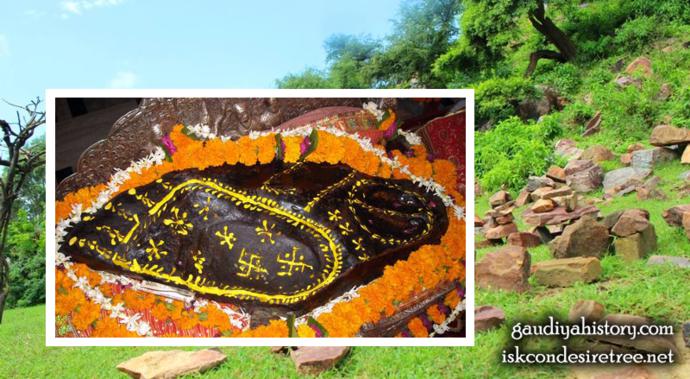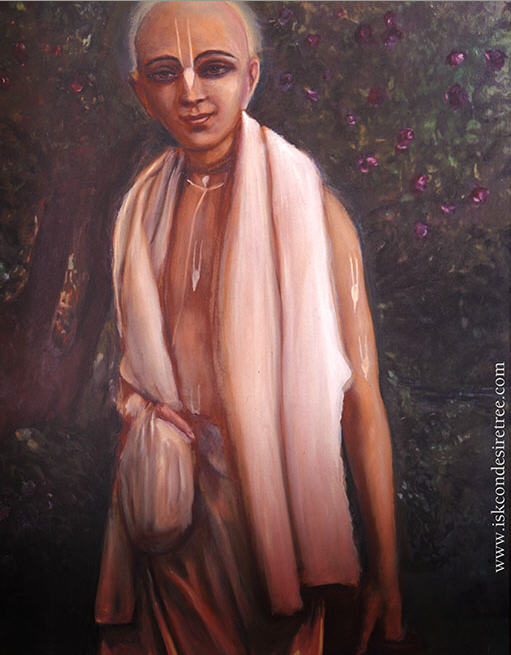
Rati Manjari, who was previously very dear to Rupa Manjari and was also known by some wise persons as Lavanga Manjari, has become the worshipable Sanatana, who is non-different from Gaura Himself. The jewel amongst sages, Sanatana Kumara, has also entered into him to fulfill a certain mission. (Gaura-ganoddesha-dipika 181) (In the image: Shrila Sanatana Goswami).
socyate nama-bhedena lavanga-maïjari budhaih
sadya gaurabhinna-tanuh sarvaradhyah sanatanah
tam eva pravishat karyan muni-ratnah sanatanah
Rati Manjari, who was previously very dear to Rupa Manjari and was also known by some wise persons as Lavanga Manjari, has become the worshipable Sanatana, who is non-different from Gaura Himself. The jewel amongst sages, Sanatana Kumara, has also entered into him to fulfill a certain mission. (Gaura-ganoddesha-dipika 181)
Sanatana’s Life Before Meeting Mahaprabhu
According to the Gaudiya Vaishnava Abhidhana, Sanatana was born in around 1410 of the Shaka era (1488 AD). Narahari Chakravarti Thakur has described his ancestors in Bhakti-ratnakara (1.541ff) and Shrila Bhaktisiddhanta Saraswati Goswami Thakur has given a summary of this information in his Anubhashya to Chaitanya Charitamrita (1.10.84), which we have quoted in this book on page 12 in our discussion of the life of Rupa Goswami. Other than this, no reliable information about their antecedents has been found. Perhaps researchers in Indian history will be able to shed more light on this.
According to the Gaudiya Vaishnava Abhidhana, the following brief account is given of how Sanatana’s grandfather came to be engaged in the Muslim Shah’s service: “During the reign of Barbak Shah (1460-1470 AD), Sanatana’s grandfather Mukunda entered the court at the capital city of Gauda. Barbak Shah engaged many Abyssinian slaves and eunuchs in both his court and harem; they were known as habshi [which is now the common Bengali word for any black African]. After the death of Barbak Shah, his son Yusuf became king, and he was followed by his son Fateh Shah. During the reign of Fateh Shah, the Abyssinians led a coup in which Fateh Shah himself was assassinated. They ruled for five or six years. Hussein Shah was the wazir or prime minister of the last of the Abyssinian rulers and he later became himself ruler of Bengal. Mukunda left this world during the rule of Fateh Shah and Mukunda was engaged in his place. Sanatana managed to survive the Abyssinian period and during Hussein Shah’s reign managed to take a higher position on the strength of his personal talents, eventually becoming prime minister. Rupa Goswami held another ministerial post, possibly as finance minister.” Sanatana’s title was Sakara Mallik and Rupa’s was Dabir Khas.
While Shri Sanatana Goswami was still young, he studied under the country’s leading scholar named Vidyavachaspati, learning many scriptures from him. He was especially attached to the study of the Shrimad Bhagavatam. Although he had taken birth in a high class Brahmin family, because he had worked for the Muslim government, he considered himself to be fallen and always behaved in a most humble manner, as is appropriate for a Vaishnava.
Sanatana’s teacher was Vidyavachaspati who would come to stay in Ramakeli from time to time. Sanatana studied all the scriptures from him. No one can achieve the depth of devotion that he had for his guru. (Bhakti-ratnakara 1.598-9)
Sanatana’s father would perform atonement rituals after even seeing a Muslim, yet Sanatana himself would associate constantly with Muslims. Being dependent on them for his livelihood, he would even go into their homes. For this reason, he considered himself to be on the same level as the Muslims and behaved very humbly. Sometimes, when he had fallen into the ocean of humility, he would think of himself as even lower than a mleccha. Because he had associated with Muslims and behaved in a lowly manner like them, he would speak of himself in that way. Though born in the highest class family of Brahmins, he never thought of himself as a Brahmin. (Bhakti-ratnakara 1.609-14)
Through Ramananda [the Lord] destroyed Cupid’s pride; through Svarupa Damodar he demonstrated detachment. Through Hari Das Thakur, he demonstrated forbearance and through Rupa and Sanatana Goswami, he taught humility. (Bhakti-ratnakara 1.630-1)
All the participants in Krishna’s lila also made their appearance in Gaura’s incarnation in order to enrich His pastimes. Through them, the Lord gives various teachings to the people of this world.
Through Hari Das, he revealed the glories of the Holy Name; through Sanatana, the articles of faith in devotional service. Through Rupa he taught Radha and Krishna’s pastimes of love. Who can understand the mysterious workings of the Lord? (Chaitanya Charitamrita 3.5.86-7)
Through Sanatana’s mercy, I learned the points of devotional doctrine, while through Rupa’s mercy, I learned about the divine devotional sentiments. (Chaitanya Charitamrita 1.5.203)
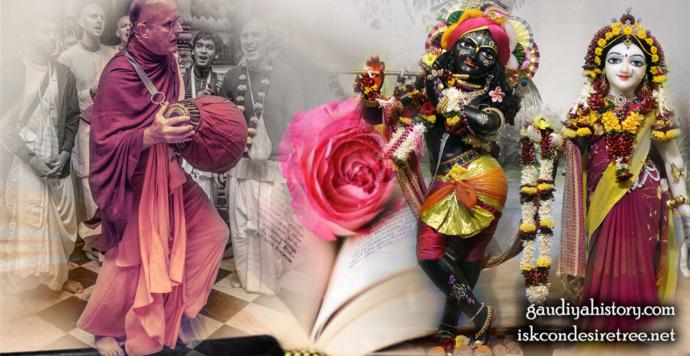
Through Hari Das, he revealed the glories of the Holy Name; through Sanatana, the articles of faith in devotional service. Through Rupa he taught Radha and Krishna’s pastimes of love. Who can understand the mysterious workings of the Lord? (Chaitanya Charitamrita 3.5.86-7) (In the wallpaper: Shri Shri Radha Madan Gopal, ISKCON Nasik, Maharashtra, His Holiness Indradyumna Swami along with Devotees in Shri Vrindavan Dham, a book).
Thus Sanatana has been called the bhakti-siddhantacharya, or the teacher of devotional doctrine, by which is meant the teacher of sambandha-jnana, or of the basic relations between God, man and the world. The founder of the Chaitanya Math, Shrila Bhaktisiddhanta Saraswati Goswami Thakur, whose various branches have spread throughout the world, mercifully gave his disciples a poem entitled “Who is a Vaishnava?” The nectarean instructions which are found in this poem mention the teachings of Mahaprabhu to Sanatana Goswami from the Chaitanya Charitamrita.
tai dushta mana nirjana bhajana
pracaricha chale kuyogi-vaibhava
prabhu sanatane parama yatane
shiksha dila yaha, cinta sei saba
So, wicked mind, you have deceptively been preaching nirjana-bhajana, the practice of the eremitic life, which is nothing more than a display, like that of a misleading yoga practitioner interested in the mystic powers. Study the teachings of the Lord to Sanatana very carefully and meditate upon them.
Shrila Bhaktisiddhanta Saraswati Goswami Thakur thus instructs us all to give great attention to the Lord’s teachings to Sanatana, or those teachings which He gave to the world through Sanatana Goswami.
First Meeting in Ramakeli
After Mahaprabhu took sannyas, He first went to Shantipur and then on to Puri and then on pilgrimage to South India. After completing His pilgrimage and returning to Puri, Mahaprabhu decided to go to Vrindavan via the route which follows the Ganges through Bengal. Great crowds of people accompanied Him and He eventually decided to turn back from Kanair Natshala. He met Rupa and Sanatana for the first time while passing through the village of Ramakeli on this voyage.
Ramakeli is in the district of Maldah in West Bengal, about eight miles south of English Bazar, which was the district headquarters, and about five or six miles from the Maldah train station. It is also known as Gupta (“hidden”) Vrindavan. There are a number of sites which are worth seeing as reminders of Rupa and Sanatana:
(1) A tamala and a kadamba tree under which Mahaprabhu is said to have been sitting when He met Rupa and Sanatana; a shrine containing the footprints of the Lord has been constructed there as a memorial of that meeting. The Lord distributed love of Krishna to all the Devotees in this location.
(2) The Temple of Madana-Mohana. This Madana-Mohana Deity was personally worshiped by Sanatana Goswami. There are also Deities of Nitai-Gauranga and Advaita Prabhus.
(3) There are several tanks, which are named Radha Kund, Shyama Kund, Surabhi Kund, Lalita Kund and Vishakha Kund.
(4) A large man-made lake named Rupa Sagara, which is said to have been excavated by Rupa Goswami, and
(5) another named Sanatana Sagara. Rupa and Sanatana had large mansions built both in Ramakeli and Fateyabad.
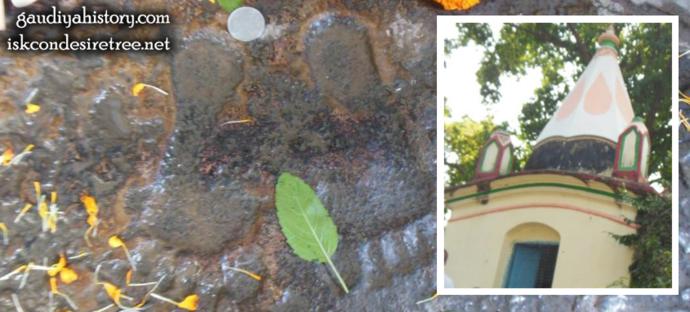
(1) A tamala and a kadamba tree under which Mahaprabhu is said to have been sitting when He met Rupa and Sanatana; a shrine containing the footprints of the Lord has been constructed there as a memorial of that meeting. The Lord distributed love of Krishna to all the Devotees in this location. (In the wallpaper: Foor prints of Lord Chaitanya, Ramkeli, Malda town).
At first, when the Muslim king heard that such great crowds of Hindus had assembled in the nearby village, he was worried. One of the Hindu members of the Shah’s court was Keshava Khattri, who explained to him that there was no reason to fear Mahaprabhu. Rupa Goswami (Dabir Khas) also glorified Mahaprabhu to the king, telling him of his fortune in having the Lord bless the country by His presence. Keshava Kshatriya, meanwhile, sent a secret message to the Lord telling Him to go elsewhere because the King could not be trusted.
The King said, “Listen, I am also beginning to think that this person must be God Himself. There is no doubt about it.” After having this conversation, the king entered his private quarters and Dabir Khas also returned to his residence. After returning there, however, he and his brother decided after much consideration to go incognito to see the Lord. Thus, in the dead of night the two brothers, Dabir Khas and Sakara Mallik, went to see Mahaprabhu. First they met Nityananda Prabhu and Hari Das Thakur. Nityananda Prabhu and Hari Das then went and told the Lord that Rupa and Sakara Mallik had come to see Him. (Chaitanya Charitamrita 2.1.180-4)
When Rupa and Sanatana met the Lord, they spoke to Him with extreme humility:
“We two are millions of times more degraded, fallen and sinful than Jagai and Madhai. We are of wicked birth because we are the servants of Muslims and our activities are exactly like those of the Muslims. We constantly associate with people who are inimical toward the cows and Brahmins. Due to our abominable activities we are now bound by the neck and hands and have been thrown into the ditch filled with the excrement of evil sense enjoyment.” (Chaitanya Charitamrita 2.1.196-199)
It is very distressful to us that we are so unworthy, yet when we see Your merciful qualities, we become desirous of attaining Your blessings. This powerful desire rises up in us as that of a dwarf who wants to touch the moon. (Chaitanya Charitamrita 2.1.204-5)
When the Lord heard the extreme humility of the two brothers, He became compassionate and said to them, “You are My eternal servants. From now on you shall be known as Rupa and Sanatana. I came to Bengal just so that I could meet you here in Ramakeli village. Krishna will deliver you from your entanglements very shortly.”
Shrila Bhaktisiddhanta Saraswati Goswami Thakur has written the following comment in his Anubhashya (Chaitanya Charitamrita 2.1.208): “Mahaprabhu showed His mercy to Dabir Khas and Sakar Mallik by giving them the spiritual names of Rupa and Sanatana, respectively. Nama-karana is a type of samskara on the lowest level of qualification. However, those who ignore the mercy that is manifest in the spiritual name have no chance of attaining devotion to Krishna, but remain intoxicated with material prestige. The prakrita-sahajiyas pay no heed to the injunctions of the scripture which state that the minimum characteristics of a Vaishnava are that he wears the symbols of the discus and conchshell and urdhva-pundra (tilaka) and takes one of the names of Krishna. As such, they cannot be qualified as Gaudiya Vaishnavas. Non-Vaishnavas have not been given a name by the Vaishnava guru and so they continue in the bodily conception of life without any awareness of their relationship with the Lord. They continue to identify themselves with their previous caste according to the name which ties them to their body.”
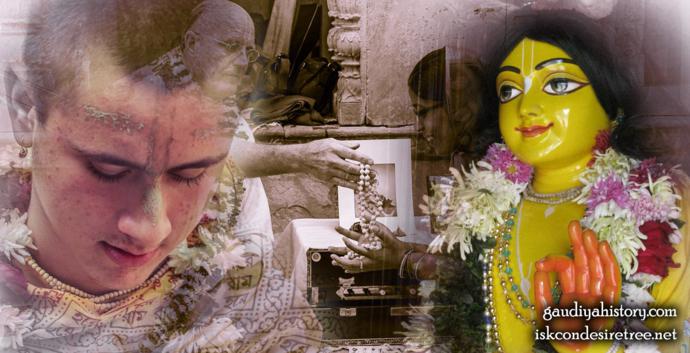
“Mahaprabhu showed His mercy to Dabir Khas and Sakar Mallik by giving them the spiritual names of Rupa and Sanatana, respectively. Nama-karana is a type of samskara on the lowest level of qualification. However, those who ignore the mercy that is manifest in the spiritual name have no chance of attaining devotion to Krishna, but remain intoxicated with material prestige. The prakrita-sahajiyas pay no heed to the injunctions of the scripture which state that the minimum characteristics of a Vaishnava are that he wears the symbols of the discus and conchshell and urdhva-pundra (tilaka) and takes one of the names of Krishna. As such, they cannot be qualified as Gaudiya Vaishnavas. Non-Vaishnavas have not been given a name by the Vaishnava guru and so they continue in the bodily conception of life without any awareness of their relationship with the Lord. They continue to identify themselves with their previous caste according to the name which ties them to their body.” (In the wallpaper: in the background His Hoilenss Indradyumna Swami is giving initiation to his disciple, in the left one more initiated Devotee, and Lord Shri Krishna Chaitanya in ISKCON Simantadwipa, Shri Navadwipa Dham).
Amongst the Lord’s companions present on this occasion were Nityananda Prabhu, Hari Das Thakur, Shrivasa Pandit, Shrila Gadadhara Pandit Goswami, Mukunda Datta, Jagadananda Pandit, Murari Gupta, Vakreshvara Pandit and many others. The Lord had them all give their blessings to Rupa and Sanatana. As the Lord was departing, the worldly-wise Sanatana said to him, You should leave this place, Lord. You have no business here. Even though the Shah has faith in You, he is a Muslim and cannot be trusted. To go on pilgrimage with such a large company of Devotees is not recommended. You are going to Vrindavan with an entourage of hundreds and thousands of people, and this is not a fitting way to go on a pilgrimage.” (Chaitanya Charitamrita 2.1.222-4)
Mahaprabhu continued on as far as Kanair Natashala, but as He considered the wisdom of Sanatana’s advice, He decided to turn back, first going to Shantipur and then to Puri.
After He and His entourage had given their mercy to Rupa and Sanatana, they left Ramakeli village. (Bhakti-ratnakara 1.635)
Sanatana Escapes from Prison
Rupa and Sanatana are the eternal associates of Krishna in Vrindavan. They appeared in this world in order to enrich Lord Gauranga’s lila by playing the role of aspirants for spiritual perfection (sadhakas). After meeting Mahaprabhu, they began to feel very impatient to change their lifestyle. They became very renounced and austere. In order to quickly be united with Mahaprabhu, they engaged two Brahmins in the performance of a purashcharana.
Shrila Rupa Goswami finally resigned from his government service and he deposited 10,000 coins on behalf of his older brother with a grocer in the capital Gauda. Then he took the rest of their accumulated wealth with him to Bakla Chandradwipa where he divided it up amongst the Vaishnavas, Brahmins and his family, while keeping a quarter of it with a trustworthy Brahmin against future necessity. He then sent two people to Puri to find out when Mahaprabhu intended to travel to Vrindavan.
Hussein Shah used to treat Sanatana Goswami as his younger brother and had great affection for him. Sanatana thought that the affection of the king, or indeed of any materialistic person, was a source of material bondage. If the king became angry with him, it would make it easier for him to break away from his entanglements. For this reason, he stopped performing his duties in the Shah’s court, pretending to be ill. Though he claimed to be seriously ill, he was in fact engaged in an intense study of the Bhagavat with a group of Sanskrit scholars.
The Shah was disquieted by Sanatana’s illness and he sent a doctor to examine him. The doctor came back and reported to the king that Sanatana was in good health and that he was studying the Bhagavat with a group of panditas. When he heard this, the Shah went to Sanatana himself and spoke to him very affectionately, trying to convince him to come back to work. Sanatana refused, however, to return to his ministerial duties and furthermore refused to accompany the Shah in the war he was preparing with Orissa. The Shah became suspicious of Sanatana and had him put in prison.
In the meantime, Rupa had received the news that Mahaprabhu had taken the jungle route through Jharikhanda for Vrindavan. He himself immediately departed for Vraja with his younger brother Anupama Mallik. He sent Sanatana a letter telling him know of his intentions, telling him to take any necessary action to free himself and then to come and join them. The letter consisted of the following Sanskrit verse:
yadupateh kva gata mathura Pur
raghupateh kva gatottara-koshala
iti vicintya kurushva manah sthiram
na sad idam jagad ity avadharaya
Where has the Mathura of the Lord of the Yadus gone? And where is the kingdom of Koshala of the Lord of the Raghus? Contemplate this and make your mind steady: beware, this world will not last forever. (Amrita-pravaha-bhashya, 2.20.3)
Sanatana was able to understand the secret meaning of the verse, which indicated that the Lord had gone to Mathura, and was overjoyed. He began to consider how he could escape from prison.
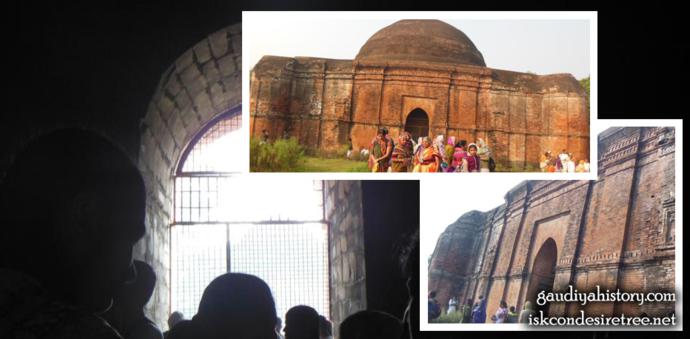
The Shah was disquieted by Sanatana’s illness and he sent a doctor to examine him. The doctor came back and reported to the king that Sanatana was in good health and that he was studying the Bhagavat with a group of panditas. When he heard this, the Shah went to Sanatana himself and spoke to him very affectionately, trying to convince him to come back to work. Sanatana refused, however, to return to his ministerial duties and furthermore refused to accompany the Shah in the war he was preparing with Orissa. The Shah became suspicious of Sanatana and had him put in prison. (In the wallpaper: The prison where Sanatana Goswami was put for 9 months, Ramkeli, Malda town).
Sanatana knew the Muslim jailkeeper, for he was the one who had hired him. He began trying to persuade him to let him go, saying that the Almighty would surely bless and give him salvation for setting free someone who had been unjustly imprisoned. The jailor remained unconvinced, so Sanatana tried to win him over by reminding him that he owed him a favor for having given him the job.
When the jail keeper still refused to let him go, Sanatana offered him a bribe of 5,000 rupees. At this, the jailkeeper’s resolve began to waver, but he was still afraid of being caught by the Badshah. Sanatana told him, “The Shah has gone to war. When he comes back, just tell him that I went to the toilet. Then when I went to the Ganges to wash myself, I jumped into the water and disappeared. Say that you looked everywhere but couldn’t find me.”
Sanatana further assured him that he would not remain in the area, as it was his intention to become a Sufi and go on the Haj to Mecca. Therefore, he need not worry on that account. The jailor remained reticent, however, and finally Sanatana had the grocer bring 7,000 rupees of the money which Rupa had left in his safekeeping and placed it directly in front of him. When he saw the money before him, the jailor became greedy and capitulated. He cut Sanatana’s chains and helped him to cross the Ganges.
In general, we consider flattery, asking return for a favor, putting temptation before someone, telling someone to lie, and bribery all to be unethical acts. Sanatana, however, used all the means at his disposal to escape bondage so that he could join the Lord and engage in His service. To achieve an auspicious end, any means may be permissible. The purity or impurity of a particular means depends on the purity or impurity of the objectives to be achieved. In order to serve his master Rama, the Supreme Brahman, Hanuman burned down Lanka, killing many living beings. Because he was acting for the pleasure of the all-auspicious Supreme Lord, however, everyone was ultimately benefited by his action, and Hanuman is still considered worshipable to this very day. On the other hand, one could bathe in a holy river three times a day and worship the Deity of the Lord, and be completely in the mode of ignorance if his objective is to do harm to other beings.
Even from the worldly point of view we see that one who commits murder is considered a criminal and is punished by the death penalty, but if one fights on the battlefield to save the nation and kills many members of an enemy army, he is not punished but rather decorated with medals. This is because he is not acting for personal ends, but for those of the collectivity. This is easy to understand, but when one acts, not for the limited purposes of serving the country, or even the entire world, but for the supremely auspicious owner of unlimited millions of universes, then that is the most justifiable of purposes and the highest benefits are attained by everyone through such actions. In the Padma-purana, it is written:
man-nimittam kritam papam api dharmaya kalpate
mam anadritya dharmo ‘pi papam syan mat-prabhavatah
Even sinful activities done for My sake are to be considered religious acts. On the other hand, pious activities done while disdaining Me are considered to be sin. This is the extent of My power.
Those who chant the Holy Names or make a show of devotion, but in fact are seeking to achieve mundane, egoistic goals, are factually engaged in sin and are destined for a hellish fate. Krishna also states in the Bhagavad-gita,
yasya nahamkrito bhava buddhir yasya na lipyate
hatvapi sa imal lokan na hanti na nibadhyate
He who is free from egotism (arising from aversion to the Absolute), and whose intelligence is not implicated (in worldly activities)–even if he kills every living being in the whole world–does not kill at all, nor does he suffer a murderer’s consequences. (Bhagavad-gita 18.17)
When causeless devotion is manifest in the soul and one’s heart has an honest eagerness to find service to the Lord, then one gives up all consideration for happiness in this world, for renunciation is a side effect of unmotivated devotion.
Ishana Nearly Gets Sanatana Killed
Sanatana had been prime minister, yet he escaped from jail with practically not a penny to his name. He did not take the main highway, but travelled as quickly as possible through fields and villages until he reached Pataria Mountain, which is part of the Raj Mahal Hills in the Chota Nagpur area in the state of Bihar. He did not know how to get across this mountain, and so requested the aid of a landowner who was also a robber chieftain. Accompanying Sanatana was a longtime personal servant named Ishana. Through the help of a palmist, the landowner was able to know that Ishana had eight gold coins in his possession, so he welcomed Sanatana into his home and treated him with great hospitality.
Sanatana was sufficiently experienced from his years in politics to become suspicious of the warm treatment he was getting from his host, and so he asked Ishana whether he was carrying anything of value. Ishana answered that he had seven gold coins, keeping his other coin a secret from him. Sanatana said, “Why have you brought this ruination upon us?” After gently chastising his servant in this way, he took the coins from him and gave them to his host, asking him to help him get across the mountain.
The landowner then revealed to Sanatana that he had known all along about the eight gold coins and that it had been his intention to murder them both that night somewhere on the mountain in order to take the money. He was very pleased that Sanatana had given him the gold and was even ready to return it to him, but Sanatana refused. He was intelligent enough to understand the adage: avyvasthita-cittasya prasado’pi bhayankarah, “even the kindness of an undependable person is dangerous.”

How can one have faith in the n/div bsp; words of a rascal? He sometimes tells the truth and sometimes falsehoods. Just as with the clouds of Shravan--sometimes there is sunshine and sometimes rain. (In the wallpaper: Mountain and gold coins).
dhurtasya vacane kvastha kvacit satyam kvacin mrisha
kvacid raudram kvacid vrishtih shrastrong vanasya ghano yatha
How can one have faith in the words of a rascal? He sometimes tells the truth and sometimes falsehoods. Just as with the clouds of Shravan–sometimes there is sunshine and sometimes rain.
After they had crossed the mountain, Sanatana told Ishana to take the remaining gold coin and return home. Ishana had shown by his attachment to this gold coin that he was not yet ready to accept a life of renunciation, that he was too dependent on material conditions. When unqualified people take the renounced orders, then these orders themselves become contaminated. This is the lesson that Sanatana gave through his servant Ishana.
Sanatana Meets the Lord in Benares
After bidding good bye to Ishana, Sanatana continued on his way until he arrived at Hajipur on the northern bank of the Ganges near Patna. Sanatana’s brother-in-law, Shrikanta, made his home there. Though Shrikanta invited him to stay there for a few days to recuperate from the voyage, Sanatana declined his invitation because of his desire to see the Lord. Shrikanta gave him a valuable blanket of Bhutanese wool.
Sanatana then continued on to Benares where he was overjoyed to learn that Mahaprabhu was staying at the house of the physician, Chandrashekhara. Sanatana did not go straight into Chandrashekhara’s house but waited on his front porch. The Lord, the indweller of all souls, knew of His Devotee’s arrival and sent Chandrashekhara to the door to invite him in. As soon as Sanatana entered, Mahaprabhu immediately rushed to embrace him. The meeting of the Lord with His Devotee affected them both so intensely that they were overcome by the transformations of ecstatic love. In His affection for Sanatana, the Lord started to brush off the dust accumulated on his body from his travels, but this caused Sanatana to feel uncomfortable. He told the Lord not to touch him, but the Lord answered,
“I touch you in order to purify Myself. Your devotional force is so great that you can purify the entire universe. I look at you, I touch you and I sing your glories. By so doing, all My senses attain their most perfect use.” (Chaitanya Charitamrita 2.20.56,60)
The Lord repeated again and again that He was touching Sanatana for His own purification and for the purification of the entire universe. Then He immediately added, “Listen Sanatana. Krishna is the ocean of mercy, He saves the most fallen. He has delivered you from the hell known as Raurava.” Sanatana is, of course, an eternal associate, so there is no question of his being truly fallen, but Mahaprabhu wished to make a point for the benefit of the people of the world. He wanted to teach that worldly honor measured in terms of one’s fortune and accumulation of sense objects is in truth misfortune, since the accumulation of material possessions for the sake of gross or subtle sense gratification ultimately leads to a hellish existence. Conditioned souls who are bewildered by the illusory energy are constantly busy working hard in order to accumulate wealth, position and influence, whether by fair means or foul. Seldom does one come across an exemplary householder who knows that Krishna is the only true enjoyer and engages all his worldly possessions in the Lord’s service rather than considering them to be the objects of his own enjoyment.
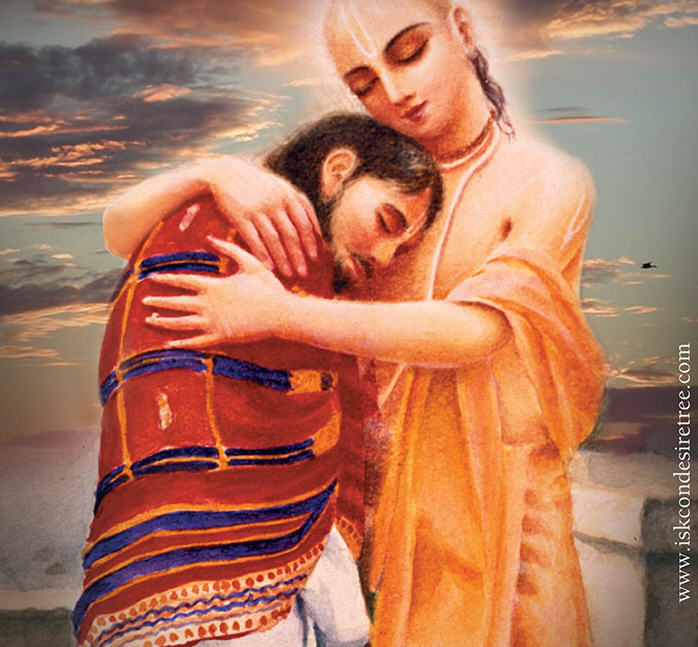
“I touch you in order to purify Myself. Your devotional force is so great that you can purify the entire universe. I look at you, I touch you and I sing your glories. By so doing, all My senses attain their most perfect use.” (Chaitanya Charitamrita 2.20.56,60) (In the image: from right to left Shri Krishna Chaitanya, Sanatana Goswami).
While Mahaprabhu was in Benares, He stayed with Chandrashekhara and took His meals at the house of Tapana Mishra. Mahaprabhu introduced Sanatana to these two Devotees, and Tapana Mishra invited Sanatana to come to his house and take Mahaprabhu’s Prasad remnants. After many days in prison and travelling, Sanatana’s hair and beard had grown long. The Lord told him to get shaved, so that he would look “respectable”. Vaishnavas in general are clean shaven, growing neither beard nor moustache. With the exception of the chaturmasya period when one does not shave nor cut the fingernails, this is the accepted practice for Vaishnava men. Vaishnava sannyasis, however, usually shave only once a month on the full moon day, as for them to shave daily would be considered unnecessary preoccupation with the body.
After being shaved, Sanatana took his bath in the Ganges. When he came back to the house, Chandrashekhara wanted to give him a new cloth, but Sanatana refused it, taking back his old one. Though he had been rich enough to give clothes to thousands of mendicants, on this day he was reluctant to accept a new cloth for himself. When one’s desire to worship the Lord is real, one becomes indifferent to nice clothes or good food. Accepting gifts from Vaishnavas or taking their remnants is an exception to this rule, however, as these do not have the poisonous character that other sense objects have. Every single one of Sanatana’s actions contains a lesson for the conscientious sadhaka.
Mahaprabhu was extremely pleased to see Sanatana’s renunciation. Thus it is said,
mahaprabhura bhakta jata vairagya pradhana
yaha dekhi’ tushta han gaura bhagavan
Renunciation is the predominating characteristic of every one of Mahaprabhu’s Devotees. When Lord Gauranga sees their renunciation, He is very pleased. (Chaitanya Charitamrita 2.6.220)

Vaishnavas in general are clean shaven, growing neither beard nor moustache. With the exception of the chaturmasya period when one does not shave nor cut the fingernails, this is the accepted practice for Vaishnava men. Vaishnava sannyasis, however, usually shave only once a month on the full moon day, as for them to shave daily would be considered unnecessary preoccupation with the body. (In the image: Harinama Sankirtana somewhere in Europe).
When one is intoxicated by material sensuality and enjoyments and engaged in competition to attain them, one is destined for a falldown from any spiritual attainment.
There was a Maharashtrian Brahmin who invited Sanatana to come daily to his house to eat for as long as he stayed in Benares. Sanatana refused, however, saying that he prefered to keep body and soul together by eating only madhukari, that is to say, by begging a handful of food from several houses each day. A pure Devotee has no desire for bodily comfort.
Sanatana Goswami had torn his old cloth into two to make a loincloth (bahirvasa) and a shawl (uttariya), but even so, he continued to wrap himself in the Bhutanese wool blanket. Mahaprabhu looked repeatedly at this blanket, and Sanatana realized that Mahaprabhu did not approve of it. That day, when he went to the Ganges ghat, he saw a Bengali mendicant washing a quilt in the river. He offered him his expensive blanket in exchange for the quilt. When Sanatana came back wearing the threadbare quilt, the Lord was pleased.
The Lord said, “I had been thinking about this. It seems that since Lord Krishna is very merciful, He has cured you of your disease of attachment to sense enjoyment. Why then would He allow you to hold fast to a last bit of material attachment? After restoring someone to health, a good physician does not allow any trace of the disease to remain. It is contradictory to practice madhukari while wearing a blanket worth three gold coins. By so doing, you would have lost your spiritual strength and become a laughing stock.” (Chaitanya Charitamrita 2.20.90-2)
Shri Chaitanya Mahaprabhu is the Supreme Personality of Godhead Himself. Even so, He played the role of the supreme teacher. He insisted that His personal associates maintain the standards of behavior that he Sanatana was sufficiently experienced from his years in politics to become suspicious of the warm treatment he was getting from his host, and so he asked Ishana whether he was carrying anything of value. Ishana answered that he had seven gold coins, keeping his other coin a secret from him. Sanatana said, set and himself followed.
I shall accept the role of a Devotee and shall teach devotional service by practicing it Myself. It is explained in the Bhagavat and the Bhagavad-gita that if one does not oneself practice a religious principle, it cannot be taught. (Chaitanya Charitamrita 1.3.20-1)
yad yad acarati shreshthas tat tad evetaro janah
sa yat pramanam kurute lokas tad anuvartate
The general masses imitate the ways of great men. They follow whatever the great personality accepts as the right conclusion. (Bhagavad-gita 3.21)
The Lord’s Teachings to Sanatana
Being pleased with Sanatana, Mahaprabhu infused him with spiritual power, giving him the capacity to ask appropriate questions about the practice of true spiritual life. Without the mercy of the Supreme Lord, genuine, honest questions on such matters cannot arise in someone’s mind. Most people ask questions thinking that they already know the right answer, simply as a sort of debating technique. No spiritual benefit arises from such types of questions. Honest questions meant to find out doctrinal truths leading to surrender are called pariprashna (“relevant inquiry”) in the Bhagavad-gita:
Tad viddhi pranipatena pariprashnena sevaya
upadekshyanti te jïanam jïaninas tattva-darshinah
You will be able to attain all this knowledge by satisfying the enlightened spiritual master with prostrate obeisances, relevant inquiry, and sincere service. Great souls who are most expert in scriptural knowledge and endowed with direct realization of the Supreme Absolute Truth will teach you that divine knowledge. (Bhagavad-gita 4.34)
On the day a person undertakes his journey on the road to liberation, when his material entanglement is about to start the process of termination, he meets a spiritual master. Sanatana Goswami was himself an ever-liberated soul and a permanent companion of the Lord, but he showed what questions the aspiring practitioner of devotional service should ask his spiritual master on that day. He said to the Lord:
“I was born in a low family and have always associated with low-class men. I am fallen and the lowest of men. Indeed, I have fallen into the well of sinful materialism and passed my whole life there. I have no idea of what is beneficial for me and what is not. In ordinary dealings, people consider me wise, and I have also come to think of myself as such. You have mercifully delivered me from the materialistic path. Now, by the same causeless mercy, please explain to me my duty. I don’t know who I am or why the threefold miseries constantly wear me down, so how can I attain the highest good? Actually, I do not even know how to inquire about the goal of life and the process for obtaining it. Please be merciful upon me and explain all these things to me.” (Chaitanya Charitamrita 2.20.99-103)
Sanatana’s first question was ami ke? “Who am I?” This is the first question which arises in the heart of a person seeking the highest good. If one makes a mistake in assessing his true identity, then he will make errors when it comes to determining the ultimate goal of life. If one makes an error in determining the ultimate goal of life, then everything he does, every effort he makes, will be wasted. All of one’s duties, religious observations and self-interest rest upon the proper knowledge of oneself. If one takes the body to be the self, then he considers the maintenance of the body itself to be the goal of life or prayojana-tattva, and one’s self-interest will be the fulfilment of goals related to the body; duties will also be considered in terms of these ends, and morality, or the determination of good and bad, will all be determined on the basis of what is good or bad for the body. On the other hand, if someone takes the subtle body to be the self, then one will consider his personal interests in terms of its development and he will consider his religious duty to help others to develop in this way. Those who consider the self to be a soul which exists beyond the gross and subtle bodies will consider its development to be their self-interest and will consider it their religious duty to help other people to develop spiritually. Those whose vision is sufficiently clear to recognize their identity as spirit soul, but find themselves in the undesirable situation of bondage to the gross and subtle material bodies, still make favorable use of these coverings in an understanding of their true self-interest, which is that of the soul. They avoid the unfavorable use of the gross and subtle bodies.
In his teachings to Sanatana Goswami, Shri Chaitanya Mahaprabhu taught that the living being’s true identity is to be Krishna’s eternal servant. The jiva is the Lord’s tatastha-shakti, or marginal energy, His separated expansion, who is simultaneously one and different from Him. The Lord taught him the sadhya and the sadhana, the goal of the seeker, and the methods by which the seeker achieves his goal. Mahaprabhu summarized the three elements of His teaching as the sambandha, saying that it was Krishna, the abhidheya, the practice which leads to perfection or devotion to Krishna, and the prayojana, the supreme goal of spiritual life or love for Krishna or prema.

The sum total of the Vedic literatures explains three things: sambandha, abhidheya and prayojana. The living entity’s eternal relationship with Krishna is called sambandha. Devotional service is the process by which one attains the supreme objective, Krishna. Devotional service, or sense activity for the satisfaction of the Lord, is called abhidheya because it can develop one's original love of Godhead, which is the goal of life, the prayojana. This goal is the living entity's topmost interest and greatest treasure. (Chaitanya Charitamrita 2.20.124-5) (In the wallpaper: Shri Govinda, ISKCON Tirupati, a girl).
The sum total of the Vedic literatures explains three things: sambandha, abhidheya and prayojana. The living entity’s eternal relationship with Krishna is called sambandha. Devotional service is the process by which one attains the supreme objective, Krishna. Devotional service, or sense activity for the satisfaction of the Lord, is called abhidheya because it can develop one's original love of Godhead, which is the goal of life, the prayojana. This goal is the living entity's topmost interest and greatest treasure. (Chaitanya Charitamrita 2.20.124-5)
All these matters have been explained at great length, with copious quotations from scripture, by Krishnadas Kaviraj Goswami in his Chaitanya Charitamrita, from the 20th to the 23rd chapters of the Madhya-lila. Rather than repeat these teachings in detail here, which would lead to this account of Sanatana Goswami’s life becoming over long, we will limit ourselves to a brief summary.
Mahaprabhu told Sanatana that the various scriptures, in particular, the Shruti, contain statements which indicate that the living being is both one with and different from the Supreme Lord. Different acharyas have put forth a variety of doctrines explaining the relation between this oneness and distinction, named advaita-vada, dvaita-vada, vishishtadvaita-vada, shuddhadvaita-vada, dvaitadvaita-vada, etc.. If one accepts the scripture, one must accept it in its entirety, including both types of affirmation, and try to find a way to harmonize the apparent contradictions. Shri Chaitanya Mahaprabhu’s solution to the problem was to establish the doctrine named achintya-bhedabheda, “inconceivable oneness and difference”. This doctrine has been looked upon favorably around the world and created a revolution in thinking.
Mahaprabhu concluded His teachings with a discourse on the atmarama verse:
atmaramash ca munayo
nirgrantha apy urukrame
kurvanty ahaitukim bhaktim
ittham-bhuta-guno harih
Self-satisfied sages who are freed from any bondage also engage in the unmotivated service of Shri Krishna, whose activities are all wonderful. Such are the transcendentally attractive features of Hari!
Mahaprabhu gave eighteen different explanations of this verse from the Shrimad Bhagavat to Sarvabhauma Bhattacharya. When Sanatana asked the Lord to allow him to hear them, Mahaprabhu treated him to 61 different interpretations.
Sanatana Goes to Vraja
After this, Mahaprabhu converted Prakashananda Saraswati and the other sannyasis of Benares to Vaishnavism. When He had completed instructing Sanatana in a most thorough fashion, He sent him to Vrindavan while He Himself took the less frequented road to Puri. Sanatana took the main highway to Vrindavan where he met Subuddhi Raya who was following Mahaprabhu’s instructions to atone for his past sins by chanting Hare Krishna. Though he was barely able to make a living selling dry wood, Subuddhi would provide for the Vaishnavas who came to Vraja from Bengal.
Sanatana took the pilgrimage circuit through the twelve forests of Vraja in the company of Subuddhi and the Sanoriya Brahmin. From them he learned that Rupa and Anupama had also completed the circuit not long before and had then taken the road along the banks of the Ganges to return to Bengal.
When Mahaprabhu Himself did the Vraja parikrama, He discovered Radha Kund and Shyama Kund near Arit village. Then He went to see the Deity of Harideva at Govardhana after which He desired to see Giridhari Gopal. The Gopal Deity of Madhavendra Puri had His Temple on top of the hill. Mahaprabhu had vowed not to walk on Govardhana, but nevertheless wished to take darshan of Gopal. While He was wondering how to solve this problem, there was a panic in the area that the Muslims were planning to destroy images throughout Vraja and so Gopal’s pujaris took Him out of His Temple and hid Him in the village of Gatholi. Mahaprabhu then could go there and take His darshan. From time to time, Gopal would perform this pastime of being moved to Gatholi in this way. Sanatana also had the good fortune to be able to visit Gopal while He was there.
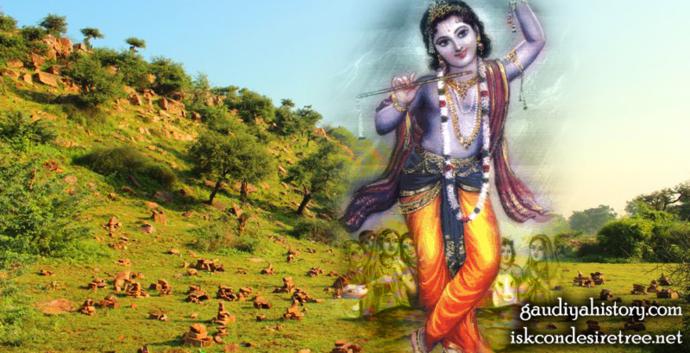
The Gopal Deity of Madhavendra Puri had His Temple on top of the hill. Mahaprabhu had vowed not to walk on Govardhana, but nevertheless wished to take darshan of Gopal. While He was wondering how to solve this problem, there was a panic in the area that the Muslims were planning to destroy images throughout Vraja and so Gopal’s pujaris took Him out of His Temple and hid Him in the village of Gatholi. Mahaprabhu then could go there and take His darshan. (In the wallpaper: Giri Govardhan, Shri Giridhari, Shri Vrindavan Dham, Uttar Pradesh).
Sanatana Visits the Lord in Puri
It took Rupa Goswami longer to get to Bengal than he had expected and so he was unable to join the other Devotees on their annual trip to Puri to see the Lord. He therefore arrived some time after the main group and went to stay with Hari Das Thakur. When Mahaprabhu met Rupa, he inquired after Sanatana and heard from him that the brothers had taken different roads and thus missed each other.
After touring Vrindavan, Sanatana Goswami took the Jharikhanda route to Puri. As a result of drinking bad water in the jungle, Sanatana came down with scabies. He became depressed as a result of the running sores on his body and in his despondency began to plan a suicide, thinking that due to his low birth and his now disgusting physical condition, he would not only be unable to go near the Temple and see Jagannath, but would also be deprived of Mahaprabhu’s darshan. He would not even be able to stay close enough to theTemple to see it, and if Lord Jagannath’s servants should accidentally touch him, he would commit a great offense. All in all, he thought it would be better to throw himself under the wheels of Jagannath’s chariot and be crushed to death while watching Mahaprabhu dance.
When he finally arrived in Puri, he went directly to see Hari Das Thakur and paid his respectful obeisances to him and Hari Das affectionately embraced him. Sanatana then began to stay with him. Thus when Mahaprabhu came to see Hari Das, as he was wont to do, Sanatana had the opportunity to see him. The Lord was so overcome by divine love when He saw Sanatana that He approached with the intention of embracing him. Sanatana retreated, however, thinking himself too impure to be touched by the Lord. Nevertheless, Mahaprabhu would not let him escape and took him in his arms by force, holding him tightly enough that the fluid oozing from Sanatana’s sores was smeared on His body, the sight of which broke Sanatana’s heart. Mahaprabhu then gave Sanatana the news of Rupa’s visit and Anupama’s devotion to Rama and his departure for Rama’s eternal abode.
On another day, the all-knowing Mahaprabhu came to Siddha Bakula where Hari Das and Sanatana stayed and suddenly confronted Sanatana with his intention to commit suicide during the Rathayatra festival. He said,
“My dear Sanatana, if I could attain Krishna by committing suicide, then I would give up millions of bodies without a moment's hesitation. But I cannot attain Krishna simply by giving up the body, but only through bhajana. There is no means other than devotional service by which to attain Him.” (Chaitanya Charitamrita 3.4.55-6)
In this way, Mahaprabhu taught the world through Sanatana that suicide is an act of the mode of ignorance which cannot be used to attain Krishna. It is only through the cultivation of pure devotion in practice that one can attain the Supreme Lord. The best forms of bhajana, or worship, are known as the nine kinds of devotional service, or nava-vidha bhakti. The best of these is the congregational chanting of the Holy Names of Krishna, Harinama-sankirtana. Finally, Mahaprabhu revealed how dear Sanatana was to him when He said,
“You have already surrendered yourself to Me, so your body is now My personal property. Why do you want to destroy another’s property? Are you unable to distinguish right from wrong? Your body is an important instrument of Mine through which I shall accomplish many things.” (Chaitanya Charitamrita 3.4.76-8)
During the Chaturmasya period, many Bengali and Orissan Devotees would come to Puri to be with the Lord, and that year they also met Sanatana. Sanatana was struck with wonder by the Lord’s dancing before Jagannath’s chariot. When the Bengali Vaishnavas returned to their homes after the four month period, Sanatana remained in Puri.
During the hot season, in the month of Jyestha, the Lord stayed with Gadadhara Pandit at Yameshvara Oota. One day, He called Sanatana to come and see Him at noontime. Rather than taking the main road leading from the Simha Dvara to the seashore, Sanatana took another path which led across the hot sands of the beach. Though Sanatana had no consciousness of the burning heat of the sand, his feet were covered in blisters when he arrived.
The Lord asked Sanatana why he had not taken the path which led from the Simha Dvara. Sanatana replied,
“I have no right to pass by the Simha-dvara, for the servants of Jagannath are always coming and going there. Since they are always using that road, I would not be able to pass withordquo; Sanatana is, of course, an eternal associate, so there is no question of his being truly fallen, but Mahaprabhu wished to make a point for the benefit of the people of the world. He wanted to teach that worldly honor measured in terms of onbsp; nenbsp; ut touching them. If that should happen, I would be ruined.” (Chaitanya Charitamrita 2.4.126-7)
Mahaprabhu was very pleased by Sanatana’s respect for Jagannath’s pujari/divs and by his humility. He answered him as follows:
“My dear Sanatana, you can save the entire universe and even the demigods and great saints are purified by touching you. Nevertheless, it is the characteristic of a Devotee to observe Vaishnava etiquette. Maintenance of Vaishnava etiquette is the ornament of a Devotee. One who transgresses these rules of behavior becomes a laughing stock and is lost both in this world and the next. By observing the etiquette, you have brought Me great satisfaction. Who else but you will set this standard?” (Chaitanya Charitamrita 3.4.126-7)

“My dear Sanatana, if I could attain Krishna by committing suicide, then I would give up millions of bodies without a moment's hesitation. But I cannot attain Krishna simply by giving up the body, but only through bhajana. There is no means other than devotional service by which to attain Him.” (Chaitanya Charitamrita 3.4.55-6)... “You have already surrendered yourself to Me, so your body is now My personal property. Why do you want to destroy another’s property? Are you unable to distinguish right from wrong? Your body is an important instrument of Mine through which I shall accomplish many things.” (Chaitanya Charitamrita 3.4.76-8) (In the wallpaper: Lotus Feet of Shri Gopinath, ISKCON Chowpatty, Mumbai, Rath, Puri, a child).
Mahaprabhu embraced Sanatana again and again, and once again, the oozing fluids from Sanatana’s blisters were smeared all over the Lord’s body.
Finally, Sanatana became so troubled by the situation that he went to discuss the matter with Jagadananda Pandit, asking him for advice on how to free himself from the offenses that he was unwillingly committing. Jagadananda suggested that Sanatana leave Puri and return to Vrindavan.
The next time that Mahaprabhu came to Siddha Bakula and embraced him, Sanatana blurted out his distress, saying that he should never have come to Puri as his coming had only resulted in his committing countless offenses. The contaminating impurities from his scabies daily touched the Lord’s body, plunging him deeper and deeper into misery. He begged Mahaprabhu for permission to leave for Vrindavan, letting Him know that it was Jagadananda who had thus advised him.
When Mahaprabhu heard this, He became angry and said,
“Jagadananda is just a newcomer, a boy. Yet, he has become so proud that he thinks he can give even you advice. You are his guru in every respect, both in material and spiritual terms and yet he gives you advice? Doesn’t he know his own worth? You are My teacher; you are an authority. And yet, like an impudent child, he is giving instructions even to someone as qualified as you.” (Chaitanya Charitamrita 3.4.158-60)
When Sanatana heard Mahaprabhu criticize Jagadananda in this way, He took it as another sign of the Pandit’s great fortune on the one hand and His own misfortune on the other.
“You accept Jagadananda into Your inner circle while venerating me. It is as though You were giving him ambrosia to drink and me the bitter juice of neem and tobacco leaves.” (Chaitanya Charitamrita 3.4.163)
Even after hearing these words, Mahaprabhu continued to take Jagadananda’s actions as a sign of impudence. Shrila Bhaktisiddhanta Saraswati Goswami Thakur has written in this connection, “Everyone has a certain status. If someone thinks that he is more important than he really is, he transgresses the lines of etiquette which are prescribed by seniority, etc., and gives advice to someone to whom he should rather offer respect. Mahaprabhu did not encourage such transgressions, but rather sought to discourage a younger Devotee like Jagadananda from behaving in this way.”
The Lord further prohibited anyone from looking upon Sanatana’s body as material.
“You take your body to be disgusting, whereas I think that your body is like nectar. Your body is transcendental, never material, but you conceive of it in material terms.” (Chaitanya Charitamrita 3.4.172-3)
When Hari Das Thakur objected that the Lord was exaggerating out of His own mercy, the Lord laughed and explained to him and Sanatana as follows:
“My dear Hari Das and Sanatana, I think of you as My adopted children and of Myself as your maintainer. The maintainer never takes seriously any faults of the maintained. I never think of Myself as deserving of respect, but because of affection I always consider you to be like My little boys. Even when a child passes stool and urine that touch her body, a mother never hates the child. On the contrary, she takes much pleasure in cleansing him and takes his filth to be like sandalwood pulp. Similarly, I felt no disgust at being touched by the fluids oozing from Sanatana’s itches.” (Chaitanya Charitamrita 3.4.184-7)
Shri Chaitanya Mahaprabhu went on to say,
“The body of a Devotee is never material. It is considered to be transcendental, full of spiritual bliss. At the time of initiation, when a Devotee fully surrenders unto the service of the Lord, Krishna accepts him to be as good as Himself. When the Devotee's body is thus transformed into ecstatic spiritual existence, he is able to render service to the lotus feet of the Lord… Krishna produced scabies on Sanatana’s body and sent him here to test Me. Had I refused to embrace him out of disgust, I would certainly have committed an offense to Krishna Himself. This is the body of an associate of Krishna. It has no foul odor coming from it. On the first day that I embraced him, I smelled the aroma of chatuhsama [a mixture of sandalwood pulp, camphor, aguru and musk].” (Chaitanya Charitamrita 3.4.191-7)
This time, when the Lord embraced Sanatana, the foul itches which covered his body immediately disappeared and his skin took on an effulgent golden glow.
Jagadananda and Sanatana in Vraja
Sanatana stayed a full year in Puri, after which Mahaprabhu told him to return to Vrindavan. He bid the Lord goodbye after the Òolayatra and took the jungle path to Vrindavan. Rupa Goswami joined him there not long afterward. When Raghunath Bhatta Goswami came to Vrindavan on Mahaprabhu’s order, he stayed with Rupa and Sanatana and daily recited the Bhagavat for them in a sweet voice.
Some time later, Jagadananda Pandit took permission from Mahaprabhu to come to Vrindavan. When he came there, he met Sanatana who was overjoyed to see him. The two of them went together on a tour of the twelve forests of Vraja. Sanatana encouraged Jagadananda to stay with him in Gokula where he was settled at that time. Even though they dwelt together, they ate separately. Shrila Bhaktivinoda Thakur writes in his Amrita-pravaha-bhashya, “Sanatana had become habituated to the madhukari system and lived on a few pieces of bread each day. Jagadananda, however, could not live without eating rice, and so he went every day to a nearby Temple to cook. In those days, even in the Temples of Vraja, rice and dahl were not regularly offered to the Deities.”
One day, Jagadananda invited Sanatana to eat with him. Sanatana desired to show the world the extent of Jagadananda’s devotion to Mahaprabhu. So when he came to eat Jagadananda’s offering, he wore around his head a saffron cloth which had been given to him by a certain Mukunda Saraswati. When Jagadananda learned that the cloth was not a gift from Mahaprabhu, he was so angry with Sanatana that he took the pot in which the rice had been cooking and threatened to hit him with it. He said,
“You are Mahaprabhu’s most important associate. No one is dearer to Him than you. How could anyone tolorate you wearing another sannyasi’s cloth around your head?” (Chaitanya Charitamrita 3.13.56-7)

Sanatana gave Him sand from the place where Krishna held the rasa dance, a stone from Govardhana, a garland of gunja berries and some dried ripe pilu fruits. Jagadananda gave all these gifts to Mahaprabhu upon his arrival in Puri; He and His Devotees especially enjoyed the pilu fruits. (In the images: Pilu fruits).
Sanatana answered by praising Jagadananda’s exclusive dedication to Gauranga Mahaprabhu:
“Well said! It is clear, Pandit Mahashaya, that you are unequalled in your love for the Lord. Only from you could I have learned this lesson, for you alone have such solid faith in the Lord.. My purpose in binding the cloth around my head has been realized, for as soon as you saw it, I was able to witness the manifestations of your love for the Lord. A Vaishnava should not wear a red-colored cloth. I will give it to someone else, for I have no further need for it.” (Chaitanya Charitamrita 3.13.56-61)
Jagadananda stayed in Vraja for two months, after which he was no longer able to tolerate being separated from Mahaprabhu. He took leave of Sanatana and headed in the direction of Jagannath Puri. As they bid each other goodbye, as gifts for Mahaprabhu, Sanatana gave Him sand from the place where Krishna held the rasa dance, a stone from Govardhana, a garland of gunja berries and some dried ripe pilu fruits. Jagadananda gave all these gifts to Mahaprabhu upon his arrival in Puri; He and His Devotees especially enjoyed the pilu fruits.
Sanatana’s Service to the Lord
Mahaprabhu gave Sanatana four responsibilities:
(1) to preach pure devotional service by establishing the doctrines of pure devotion;
(2) to discover and make known the various places where Krishna had His pastimes;
(3) to establish the service of the Deity of Krishna in Vrindavan; and
(4), to establish proper Vaishnava behavior through compiling a Vaishnava rule book or smriti, and in this way make the foundations of a Vaishnava society.
“O Sanatana, you should broadcast the revealed scriptures on devotional service and excavate the lost places of pilgrimage in the district of Mathura. Establish the Deity service of Lord Krishna in Vrindavan. You should also compile a scripture containing the rules of devotional practice and preach these practices.” (Chaitanya Charitamrita 2.23.97-8)
In following the instructions to broadcast the revealed scriptures on pure devotional service and to establish the foundations of proper Vaishnava practice and etiquette, Sanatana wrote four books, all of which are considered to be jewels by the Devotees. He wrote (1) a commentary on the Haribhakti-vilasa known as Digdarshani, (2) a commentary on the tenth canto of the Shrimad Bhagavatam known as the Brihad-Vaishnava-Toshani, (3) Lila-stava or Dashama-charita, and (4) Brihad-Bhagavatamrita, to which he added a commentary. Mahaprabhu Himself gave directions to Sanatana about the contents of the Hari-bhakti-vilasa, which is the smriti scripture, or rule book for the external practices to be followed by the Devotees.
Sanatana spent a great deal of time searching out the various holy spots in the land of Vraja. He also established the service of the Madana Mohana Deity. Shrila Sanatana Goswami founded a math in Vrindavan at the place known as Dvadashaditya Öila. He first had a Temple built there for Radha-Madana Mohana. It is said that a rich officer in the Sultan’s army named Krishna Das Kapura built the Temple and a kitchen and financed an opulent standard of worship for the Deity. He later became Sanatana Goswami’s disciple.
When Sanatana Goswami was staying in Gokula Mahavana, he saw Madana Gopal playing with a group of cowherd boys at Ramanareti. Narahari Chakravarti has given a beautiful description of this vision in his Bhakti-ratnakara:
O Shrinivas, just look at this place. Sanatana Goswami used to live here. All the fortunate residents of Mahavana would be revitalized by seeing him. He joyfully lived in Mahavana looking upon his Madana Gopal Deity. Madana Gopal enjoyed playing on the sandy beaches which line the Yamuna, known as Ramana Reti. One day He came to that divine riverbank with the children of Mahavana, Himself taking the form of a cowherd boy. Sanatana watched him as He played various childhood games with the other children and thought, “This is no ordinary child.” When the children had finished playing and were leaving, Sanatana followed them. The child entered into the Temple and when Sanatana followed him inside, he saw no one but the Deity of Madana Mohana. He paid his obeisances to the Deity and then returned to his own dwelling without saying anything to anyone. So this is how Madana Mohan showed Himself to be under the control of Sanatana’s love. Sanatana’s wondrous character has thus filled the three worlds. (Bhakti-ratnakara 5.177-186)

Sanatana watched him as He played various childhood games with the other children and thought, “This is no ordinary child.” When the children had finished playing and were leaving, Sanatana followed them. The child entered into the Temple and when Sanatana followed him inside, he saw no one but the Deity of Madana Mohana. He paid his obeisances to the Deity and then returned to his own dwelling without saying anything to anyone. So this is how Madana Mohan showed Himself to be under the control of Sanatana’s love. (In the wallpaper: backside image is of Madan Mohan Temple, Shri Vrindavan Dham, Shri Madan Mohan, Karoli, Rajastan, and kids).
Sanatana’s Glorious Pastimes in Vraja
Krishnadas Kaviraj Goswami has described in his Chaitanya Charitamrita how Rupa and Sanatana Goswami worshiped Krishna in the land of Vraja:
These brothers have no fixed residence. They spend each night beneath a different tree in the forest, one night under one tree and the next under another. Sometimes, they begged dry food from a Brahmin’s house and sometimes cooked food like dry bread and fried chick-peas. This is how they have given up all kinds of material enjoyments. They wrap themselves in a quilt and wear noting but a piece of torn cloth, claiming nothing but a waterpot as a possession. They engage almost twenty-four hours daily in rendering service to the Lord by chanting the Holy Names of Krishna and discussing His pastimes or dancing in great jubilation. They spend only an hour and a half in sleep, and some days, when overcome by the love of chanting the Lord's Holy Name, they do not sleep at all. Sometimes they write transcendental works about divine aesthetics, and sometimes they listen to talks about Shri Chaitanya Mahaprabhu or spend their time thinking about the Lord. (Chaitanya Charitamrita 2.19.127-31)
While staying at Chakratirtha near Govardhana, Sanatana would regularly circumambulate the mountain. As he grew older, he became too weak to walk these 14 miles on a daily basis without becoming excessively fatigued. One day, Gopinath Himself came in the form of a cowherd boy to fan him when he became too tired from walking. After refreshing Sanatana in this way, the boy climbed onto the hill and brought down a stone marked with Krishna’s footprint. He gave the stone to Sanatana and said, “You have grown old. There is no need for you to trouble yourself to this extent any longer. I am giving you this stone from Govardhana. If you circumambulate this stone, you can consider yourself to have circumambulated Govardhana itself.” Then He disappeared. No longer able to see the charming form of the cowherd boy, Sanatana was overwhelmed with pain and began to cry. This story has also been told in the (Bhakti-ratnakara 5.728-741).
Chakratirtha is on the northern shore of Manasi Ganga. There is a Temple dedicated to Chakreshvara Shiva, or as he is popularly known, Chakreshvara Mahadeva. Sanatana’s bhajana-kutira was under a neem tree which stood in front of this Temple. Just north of this place is a Temple which houses Gaura-Nityananda. Sanatana Prabhu’s Govardhana-Shila is currently kept in the Radha-Damodar Temple at Radha Kund.
There are more stories about the glories of Chakratirtha. When Sanatana first came to this place, there were so many mosquitos that he was unable to concentrate while meditating on the Holy Name or writing transcendental literature, so much so that he decided to move. That night, Chakreshvara appeared to Sanatana in a dream and told him not to worry about the problem. He would be able to engage in his worship without disturbance. From that night on, there were no more mosquitos at Chakratirtha.
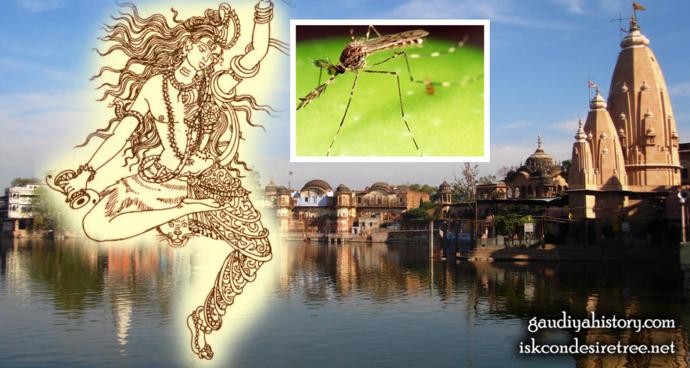
That night, Chakreshvara appeared to Sanatana in a dream and told him not to worry about the problem. He would be able to engage in his worship without disturbance. From that night on, there were no more mosquitos at Chakratirtha. (In the wallpaper: Manasi Ganga, Shri Vrindavan Dham, Lord Shiva, mosquito).
Shrila Sanatana Goswami also spent some time living in a cottage on the banks of Pavana Sarovara near Nandagrama. Here also he was granted a vision of Krishna as a cowherd boy, who gave him milk and told him to build a hut and engage in His worship there. One day, Rupa invited Sanatana to come and eat with him. For this occasion, he wished to prepare sweet rice, but he did not have the necessary ingredients. Shrimati Radharani took the form of a young cowherd girl and came to Rupa with milk, sugar, rice and ghee, in short, giving him everything he needed to make the preparation for Sanatana’s pleasure. Rupa Goswami cooked the sweet rice and after offering it to the Deity, gave the Prasad to Sanatana. Sanatana found that after relishing the delicious sweet rice, he was overcome by uncontrollable waves of ecstasy. Suspecting that something unusual had taken place, he asked Rupa where the ingredients had come from. When Rupa told him about the little cowherd girl, Sanatana immediately realized that it had been Radha. Because Radha was their goddess and they were her servants, the proper relation of served and servant had been reversed. He therefore strictly forbad Rupa from accepting such gifts in the future. (Bhakti-ratnakara 5.1311-30)
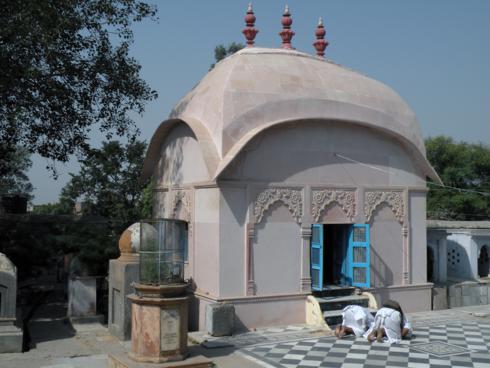
Sanatana Goswami’s samadhi tomb is found next to the old Radha-Madana Mohana Temple in Vrindavan. He left this world on the full moon day of Asharh in the Shaka year 1480 (1558 AD). (In the image: Samadhi of Shrila Sanatana Goswami).
Another legend told about Sanatana is the following. Once there was a very poor Devotee of Shiva, whose name, according to the Bhaktamala and Gaudiya Vaishnava Abhidhana, was Shri Jivana Chakravarti. Originally from the village of Manakara in Burdwan district in Bengal, he had spent many years worshiping Shiva in Benares, praying to him for wealth. Finally, one night Shiva appeared to him in a dream and told him to go to Sanatana in Vrindavan, for he was in possession of a great wealth which he would share with him.
The poor Brahmin immediately set off for Vrindavan where he found Sanatana deep in meditation. However, when he saw the Goswami, thin and dressed in a dirty loincloth, he began to doubt that he could give him the desired riches. Even so, he told Sanatana about the dream. Sanatana heard the Brahmin and came back to external consciousness. He answered saying that he lived by begging a few crumbs from a number of different houses, how could he possibly give him the riches he desired?
The poor Brahmin was disappointed and turned away, thinking that perhaps the message Shiva had given him in the dream had just been an illusion. Meanwhile, Sanatana pondered why Shiva had sent the Brahmin to him. As he ruminated, he remembered a philosopher’s stone that was lying in a pile of rubbish and had long since been covered in dust. As soon as he remembered the existence of this valuable jewel, he sent someone to fetch the Brahmin and told him to take the jewel from the rubbish heap.
When the Brahmin saw the touchstone, he was overjoyed and thought, now there will be no one as rich as I in the entire world! After walking some distance away, however, he began to wonder why Sanatana had completely forgotten about such a valuable possession. Indeed, if he cared so little for the philosopher’s stone, he must have something even more valuable. Perhaps he had been cheated! He wanted to know what riches Sanatana possessed that he cared so little for the touchstone.
The Brahmin quickly ran back to Sanatana and expressed his doubts, asking him if he had anything more valuable in his possession. Then Sanatana told him that there was no greater wealth than love for Krishna and that material goods were insignificant and simply a cause of greater distress. The Brahmin then bowed his head and prayed to Sanatana to please give him the wealth which made him consider even a touchstone insignificant. Sanatana was moved by his prayer and mercifully bestowed upon him the riches of Krishna-prema.
Sanatana Goswami’s samadhi tomb is found next to the old Radha-Madana Mohana Temple in Vrindavan. He left this world on the full moon day of Asharh in the Shaka year 1480 (1558 AD).
[Excerpted from “Shri Chaitanya: His Life & Associates” by Shrila Bhakti Ballabh Tirtha Maharaj]
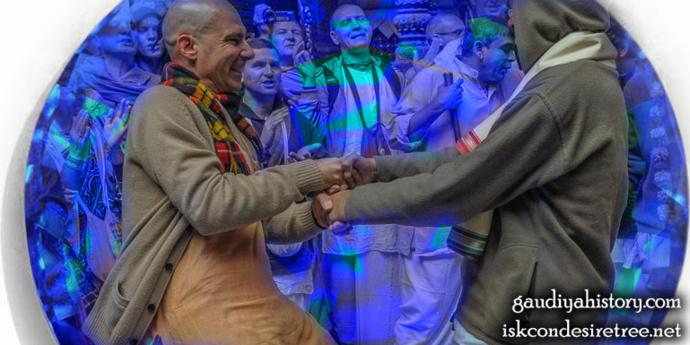
The Brahmin then bowed his head and prayed to Sanatana to please give him the wealth which made him consider even a touchstone insignificant. Sanatana was moved by his prayer and mercifully bestowed upon him the riches of Krishna-prema. (In the wallpaper: Sankirtana Yagya somewhere in Europe).

